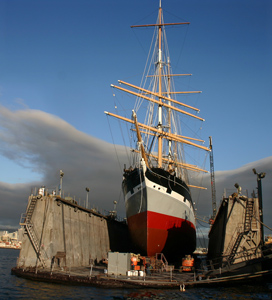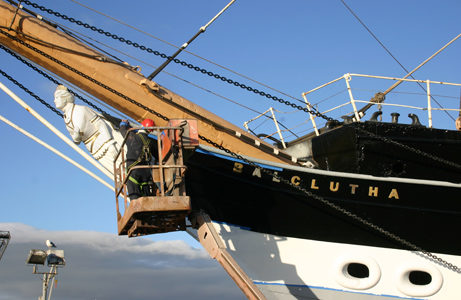A million-dollar contract was recently awarded by the San Francisco Maritime National Historic Park to Bay Ship & Yacht Co. of Alameda for the restoration of the historic three-masted, steel-hulled, square-rigged sailing ship Balclutha.

The Balclutha in drydock at Bay Ship & Yacht in Alameda. Photo by Eric Balderston, courtesy Bay Ship & Yacht.
By Wes Starratt
Published: February, 2009
A million-dollar contract was recently awarded by the San Francisco Maritime National Historic Park to Bay Ship & Yacht Co. of Alameda for the restoration of the historic three-masted, steel-hulled, square-rigged sailing ship Balclutha. Known locally as the National Maritime Museum, the park is operated by the National Park Service.
Fred Shepherd, facility coordinator for the park—located adjacent to San Francisco’s Fishermen’s Wharf—points out that the ship is a star attraction at the park, which has almost one million visitors per year. The three-masted sailing ship was built in 1886 in Glasgow, Scotland, for the purpose of carrying bulk cargos, such as coal and grain, between Europe and the West Coast of North America. As such, she rounded treacherous Cape Horn at the southern tip of South America some 17 times before being transferred to the Alaskan and the Hawaiian trade. She also appeared in the celebrated 1935 film Mutiny on the Bounty.
On a recent calm winter day, the Balclutha was gently nudged by two Westar Marine Services tugs from the Hyde Street Pier of the National Maritime Museum, slowly towed across the bay, and brought into the 400-feet-long floating drydock at Bay Ship & Yacht’s shipyard along the Alameda estuary. As the water was pumped from the drydock, the entire ship—hull and all—could be seen in her full magnificence. Bill Elliott, the shipyard’s general manager, said, She is in an amazing condition for a ship that was built more than 120 years ago. Nevertheless, we did a complete ultrasonic testing of the entire hull below the waterline, followed by needed sandblasting, steel repair, and some plate replacement. Then, we painted the entire hull below the waterline. Taking a look at her in the drydock, Elliot said, She is an overwhelming sight to behold.
The ship is expected to be in drydock for three weeks while hull repairs are being made, and then will dock alongside the shipyard’s main pier for several months of topside work. There are 12 major items of required repair work, explained Shepherd of the National Park Service. These include caulking major portions of some of the leaky decks, removing the yard arms from the masts for sand-blasting, inspection and maintenance work, repairing fittings in the rigging, painting the main mast, and a lot more. She will be ship shape by the time that all of that work has been completed, said Shepherd.
By spring, tugs will arrive at the Bay Ship & Yacht shipyard and gently nudge the 123-year old ship, in tip-top shape, back across the bay to the National Maritime Museum’s Hyde Street Pier in San Francisco, ready for inspection by thousands of more visitors, curious about their national maritime heritage.

A Bay Ship & Yacht employee works on the bow of the Balclutha while she sits in drydock. Photo by Eric Balderston, courtesy Bay Ship & Yacht.

